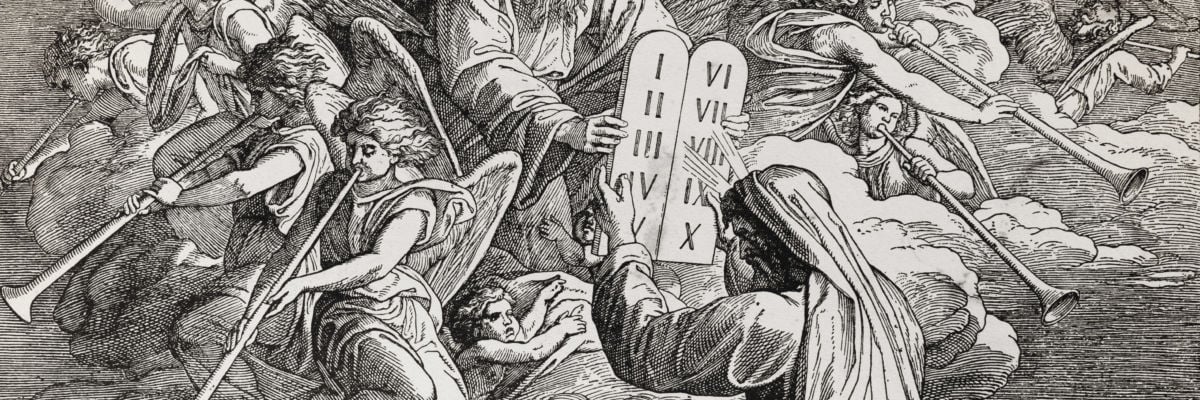
We read in Psalm 32/33: “Give thanks to the Lord on the harp; on the ten-stringed lyre offer praise.” Have you ever sung responses to each of the ten commandments? In the Anglican Ordinariate liturgy approved by the Holy See, the ten commandments are occasionally proclaimed at the beginning of the Mass as a kind of litany. The priest intones, “God spake these words and said . . .” and recites them one by one. After each, the choir and people sing, “Lord have mercy upon us, and incline our hearts to keep this law.”
I grew up with this monthly usage, and it is both nice and a bit strange that Holy Church has incorporated it into her official worship—a bit strange because the Anglican division of the commandments is different from the traditional Latin-rite Catholic one. How, and why so? More on this later.
But as the ten-string lyre reminds us, they are all about singing God’s praise. St. Augustine takes the verse of the psalm just quoted and makes it the occasion of an instruction on the ten commandments. He tells us elsewhere in his great commentaries on the psalms (his first sermon series in Hippo) that we will be God’s living praise if we live well. It is not surprising, then, that he finds the symbol of right living—namely, the ten commandments—in the type of the ten-stringed lyre. Living in accordance with the commandments is a song of praise sung on that tenfold law.
But the Law is two before it is ten. It is, as the Savior taught, summed up in the “first and great commandment”: “Thou shalt love the Lord thy God with all thy heart and with all thy soul with all thy mind,” and in the second, “which is like unto” the first: “Thou shalt love thy neighbor as thyself.”
For this reason, Augustine tells us that the first of Moses’ tablets of the Law regards the love of God, and the second tablet regards the love of neighbor. So the commandments are three on one tablet and seven on the other. Just as the first tablet begins with the source of our existence, God our Father, and then moves to the other Divine Persons in the second and the third commandments, so too the second tablet begins with the source of our earthly life and our first neighbors, our parents, and then proceeds to the other relationships and aspects of life whereby we love our neighbor, giving seven, together making ten.
This division has always been in use in the Western church. It is the division of the commandments common to Roman Catholics and Lutherans, following Augustine’s scheme. In the Eastern Church and with all the Jews and Protestants except the Lutherans, there are also ten commandments, but they are divided five and five between the two tablets, with no reference to their ordering according to the summary commandments of love. Either tradition is fine.
The Catechism of the Catholic Church tells us precisely what I have just said here:
The division and numbering of the commandments have varied in the course of history. The present catechism follows the division of the commandments established by St. Augustine, which has become traditional in the Catholic Church. It is also that of the Lutheran confessions. The Greek Fathers worked out a slightly different division, which is found in the Orthodox Churches and Reformed communities.
The ten commandments state what is required in the love of God and love of neighbor. The first three concern love of God, and the other seven love of neighbor.
As charity comprises the two commandments to which the Lord related the whole Law and the prophets . . . so the ten commandments were themselves given on two tablets. Three were written on one tablet and seven on the other (2066-2067).
So it is simply untrue to claim that the division of the first commandment into two is a Protestant variation against the Catholic veneration of images, allowing for a separate second commandment against the worship of idols. Not at all, for the Eastern fathers, who taught the veneration of images even more intensely than the Western fathers did, interpret this numbering as forbidding not images in worship, but only images of false Gods, and the true God and his angels and saints are not idols. And after all, anyone who has visited a Protestant church of any stripe nowadays will find there at least some image of Jesus or the apostles or the Holy Family. If you visit a Lutheran church in Germany, you will always find the crucifix on the altar, and altar pieces with images of Our Lady and the Holy Child, and even a number of saints not found in the bible. Indeed, the second commandment in the Catholic numbering, which commands reverence for the Holy Name, teaches us to venerate a sign, a symbol, an audible image, since a word represents the one it names, just like a picture. There is precious little difference between a word and a picture in this regard. And, sad to say, in my experience, devout Protestants are less likely to speak the Lord’s name in vain than devout Catholics! So they, too, venerate images, and sometimes better than we do.
The enumeration of the commandments is one of those things, what the scholastic teachers of the Middle Ages called “a distinction without a difference.” The text of the ten commandments we find in holy writ did not come with an enumeration, and Deuteronomy tells us even so that there are ten commandments on Moses’ tablets, and so we divide them by custom, but we all share the same text.
That being said, I allow myself to say that St. Augustine’s division is better didactically. It teaches at one and the same time the ten commandments and their essence found in the commandment of love, which is twofold, and the origin of each in creation and procreation, and so makes us understand more deeply their meaning.
In fact, the Savior has simplified things even further, by giving us his one, new commandment: “Love one another as I have loved you.” If we fulfill this one, we will fulfill the two and the ten, no matter how we divide them. Then fulfilling the commandments will not only be a psalm; it will be a love song! And Solomon’s Canticle of Canticles will be our new Exodus and Deuteronomy . . .



